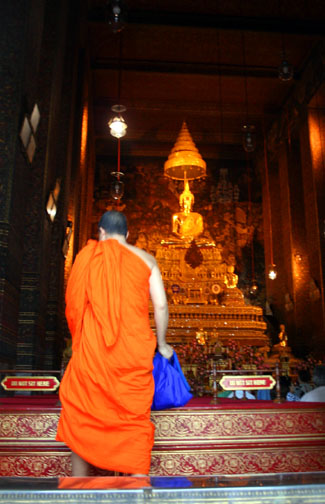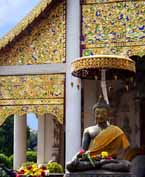Tags
It doesn’t help that translating from Thai into English means there are always multiple correct ways to spell a word. Though technically none are correct since they’re not in Thai; close is supposed to only count in horseshoes. Matters are not improved thanks to the internet where all it takes is one person to unintentionally post incorrect info that is then copied and pasted over and over again until it becomes an accepted truth. When it come to Buddhist temples in Thailand, in the grand scheme of things it may not matter anyway – you certainly can enjoy visiting a wat in SE Asia without knowing what any of the buildings are or what purpose they serve. But many visitors like to know what a temple’s larger buildings are and what purpose they serve. Generally, the largest and most imposing building within a temple’s grounds is the wiharn. Or viharn. Or wihan. Or wihara. Whichever term you prefer is as correct as the next. Unless you are speaking about the wat’s ubosot.
And therein lays the problem. The ubosot, or bot – just to keep things straight – is also many times a impressive and large building. At some wats it is larger than the wiharn. There is no specific order regarding layout at a temple, so at one wat the first structure – and what appears to the focal building – you’ll see is the wiharn. At others it will be the bot. And at still others they are side by side. They both can, and often do, contain an altar with a large central Buddha figure. The more well-known statue of the Buddha is sometimes in the wiharn. And sometimes it’s in the wat’s bot.

A wat’s bot can be identified by the sema stones surrounding its exterior, though identifying the sema stones can sometimes be tricky.
Of the two, the ubosot is the most sacred. Even when it is the smaller of the two and tucked away in a corner. Some wats have more than one wiharn. But there is never more than one bot. Though there may be a wiharn and no ubosot at all. It’s no wonder many Westerners just call them chapels, temples, or buildings to avoid any attempt at identifying which is which and most likely, getting the identification wrong.
In an attempt to be English-speaker friendly, a lot of guide books and website call a wiharn the Assembly Hall, Prayer Hall, or Sermon Hall and the ubosot the Ordination Hall. Unfortunately they also use those terms for either of the two buildings, possibly thanks to not actually knowing which is which themselves. In function these English terms serve well when they are correctly applied. The wiharn is used as a public place where both monks and the faithful pray and participate in ceremonies. The ubosot is generally reserved for use by monks and is usually the building where morning and evening prayers are said. However, you know how Thai are about rules. So you may observe monks performing their morning and evening prayers in the wiharn sometimes. And some bots, such as the one at Wat Pho, are routinely used by lay people for praying.

Wat Chedi Luang in Chiang Mai is best known for its humongous chedi. Its impressive wiharn at the front of the wat is often called a bot on the internet, which unusually enough is not necessarily incorrect.
The one constant is that the ubosot is the building where new monks are ordained, hence the Ordination Hall moniker. (If the wat does not have a ubosot, then new monks cannot be ordained at that temple.) You can usually tell the difference between the two in that the bot always has eight boundary markers, called sema stones, with one each placed at the corners and axes of its exterior. But don’t forget, you are in Thailand where rules were not only made to be broken, but are often completely ignored too.
Wat Chedi Luang in Chiang Mai is the city’s most popular religious destination for touri. It has a massive wiharn at the front of the grounds, with its famous crumbling chedi located directly behind that building. There are also several smaller wiharn behind the chedi. And the ubosot? There is a small, nondescript one tucked away on the temple’s grounds, but it has not been used since the mid-1980s. Instead, the main wiharn was allocated and marked to serve as an ordination hall; the wat’s impressive wiharn has doubled as its ubosot since 1979.
Generally, both the wiharn and ubosot are enclosed structures; they have four walls and a roof. Open-air structures within a temple’s compound are called a sala when used for sermons. But some wiharn, such as at Wat Suab Dok in Chiang Mai, are also built in this style. Just in case you were not sufficiently confused.
Because of its fame and familiarity to most touri, Wat Pho in Bangkok is a good example of a temples’ wiharn and ubosot and why and how the two can be so easily confused. Most people immediately think of the giant Reclining Buddha when you mention Wat Pho, and for many touri that is about all they see on their visit because time is short and they still have to rush off to view Jim Thompson’s house that day. The Reclining Buddha, as impressive as it is, is located inside one of Wat Pho’s wiharn (the temple has nine). As popular as the statue is, from a religious standpoint it is one of the lesser of the wat’s wiharn. Even though it is far more grand than the others.

The ubosot at Wat Phra Singh is quite ornate and spectacular in its own right, but smaller and stuck behind the temple’s more massive wiharn.
The four main wiharn at Wat Pho are arranged at each of the four compass points and surround the wat’s ubosot (coming from the Reclining Buddha, the first wiharn you’d encounter is the western one). Sometimes they are referred to as the directional wiharn. The remaining four wiharn are L-shaped and sit in each of the northern compound’s corners, two of which are often referred to as galleries.
Why as a visitor should you care which building is a bot and which is a wiharn? While in either you should remember you are in a house of worship and conduct yourself accordingly, you should be even more respectful when visiting a bot. Depending on the temple, the ubosot may not be open, or may not be open to non-Buddhist visitors. Technically, women are not allowed in a bot at any time, though this prohibition is enforced at some wats and not strictly enforced at others (watch for a sign, or make sure there are other women visiting the building before entering). The wiharn is usually the best place to interact with a monk, the bot the best place to head during morning or evening prayers – in case you are short on time and want to make the most out of your visit.
Related Posts You Might Enjoy:






Armed with this new knowledge, we visited wat Umongmahaterachan in Chiang Mai this morning. Bf was duly impressed that I knew sema stones and we found the ubot which was closed. The ubot has eight stones and even some are doubled for good measure. It’s a very nice little building.
Bf enquired by an old monk wether he could open it for us.
Answer : no you only two, only for big groups…
Comment of Bf : business everywhere !
TIT
LOL
Yup, even Buddha is into baht!
I haven’t visited that wat yet. It’s now on my list.
Thanks Lucky!
What time of day works best for your infamous “bathing monk shots”? 😉
Couldn’t tell you the best time, but there is a reason I’ve set a particular day for my Wednesday Wetness posts.
🙂
Having a combined Ubosot/Wiharn is a feature of Wats in Nan and the surrounding area. Wat Phumin is the best known example, and the only one I have visited. It was built like that in the 16th century (CE).
Incidentally, you asked a while back about the meaning of the banners you see around Northern Thailand, especially in the grounds of Wats. The answer seems to be many meanings. There was a small display in Nan National Museum. They have a non-Buddhist origin (although they have been adopted by Buddhism and a lot of the ones you see in Wats are rather like European or American wayside pulpits with a moral or religious maxim). The banners were originally made for specific purposes by priests/shamans (call them what you will). One specific example given was three banners for a funeral. The other was, if you see exactly two together at some apparently random place in the countryside then that is the site of a violent or accidental death. In both cases the purpose of the banners is to facilitate the passage of the deceased to the next life.
Thanks for that info Ceejay. I’m thinking that might explain the possible bot on top of the wiharn at Wat Phan On too.
Well was the monk at least cute?
🙂
All monks are cute.
Well, at least the ones under 30!